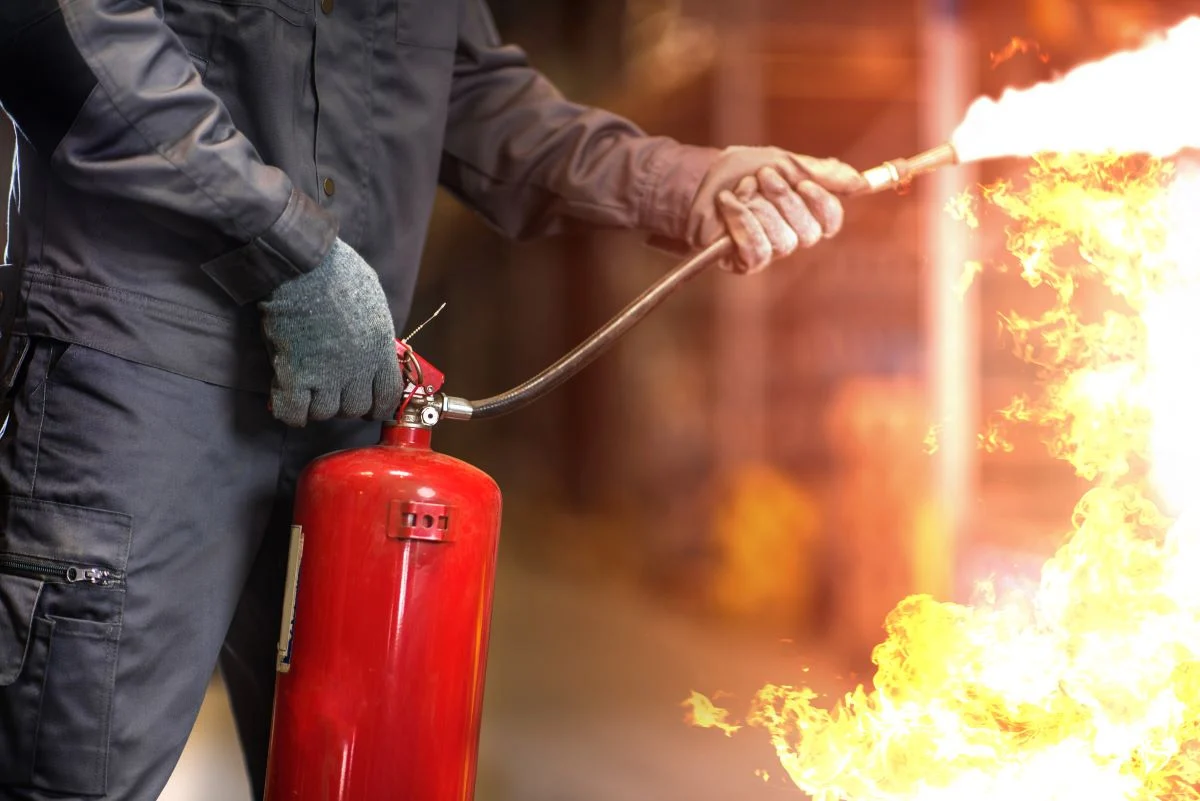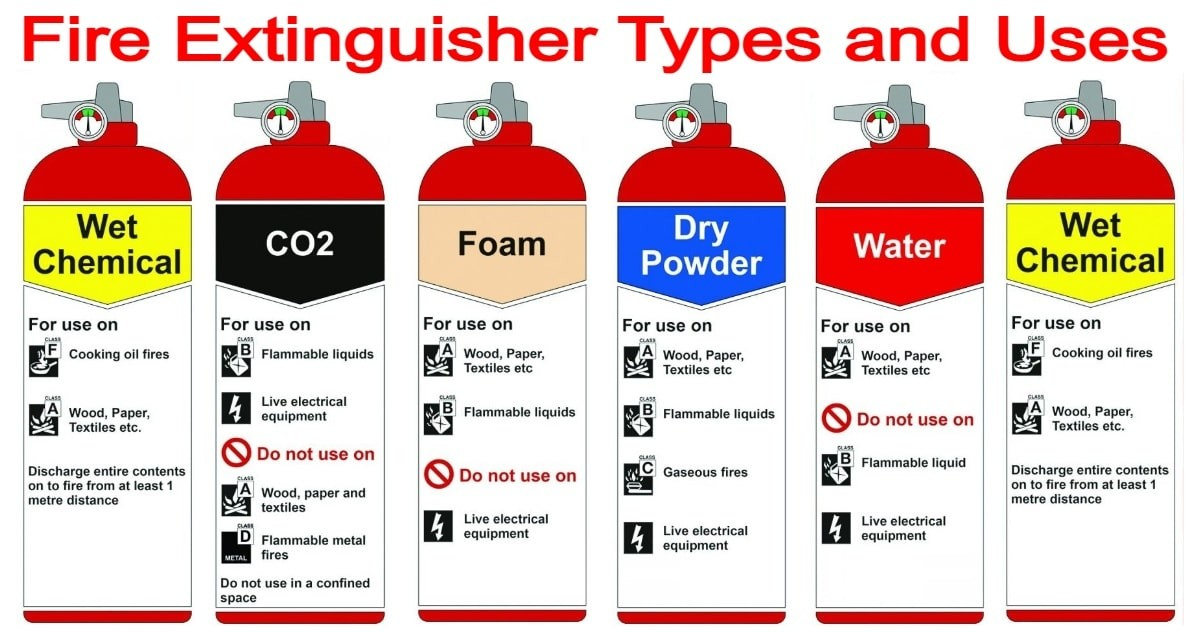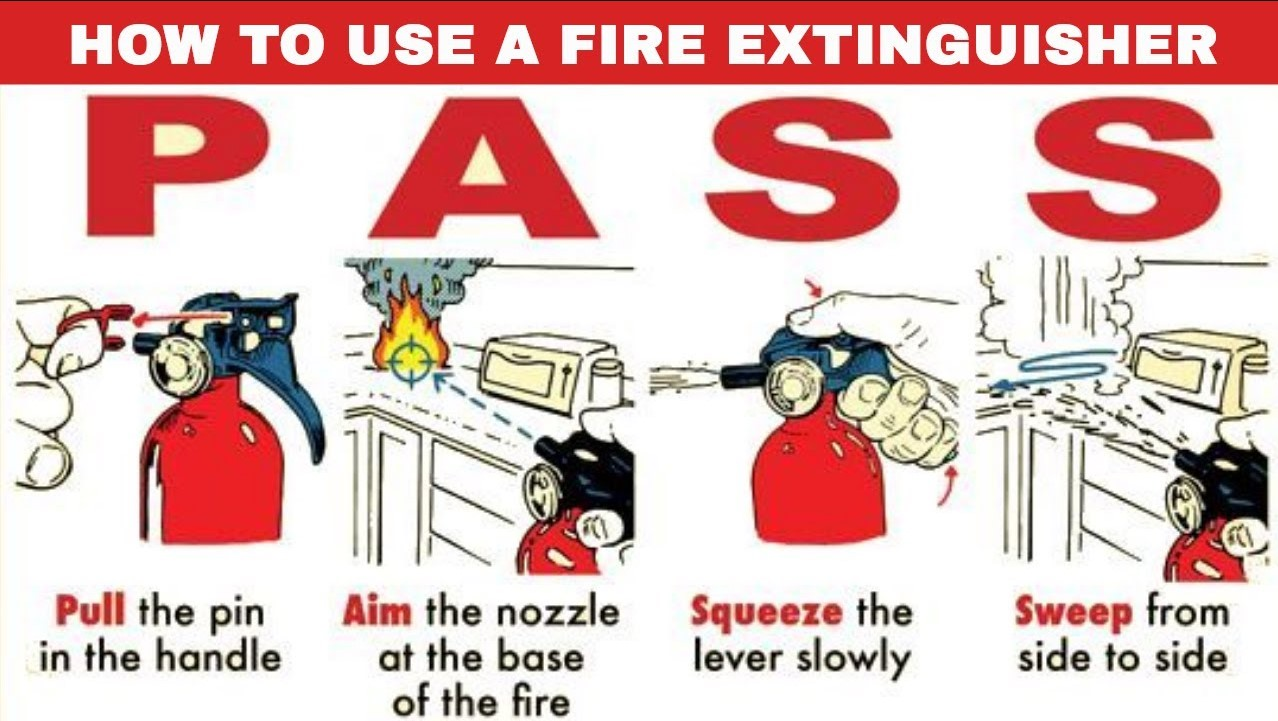
Fire Extinguisher - Safety Tips
Are you prepared for a fire emergency? Choosing the right portable fire extinguisher is not just a matter of safety; it’s a necessity for ensuring the right response to various fire scenarios. With various types of fires, such as Class A fires which involve common combustibles like wood and paper, the right extinguishing agent becomes crucial. A “wet chemical” extinguisher is specifically designed to combat these and other types of fires by cooling and creating a barrier against re-ignition.
In this blog post, we delve into the world of fire extinguishers, focusing on understanding the differences and applications of each class. Whether it’s for home, business, or industrial use, knowing how to select and utilize these vital safety tools is essential. Here, we’ll cover practical safety tips and the effectiveness of different extinguishing agents, empowering you with knowledge to protect yourself, your family, and your property. Stay tuned as we explore how these tools of safety can become your first line of defense in a fire emergency.
Getting started with portable fire extinguishers
Before diving into the world of fire extinguishers, it's essential to understand their significance. Class A fires involve ordinary combustibles, while flammable liquids require specialized attention. Knowing these distinctions can guide your interaction with fire departments when selecting the best extinguisher for your needs.
Understanding fire extinguisher types and classes
Fire extinguishers are categorized based on the type of burning material they are designed to combat. Recognizing whether a fire involves ordinary combustibles, flammable liquids, or flammable gases is crucial in selecting the appropriate class of extinguisher, ensuring effectiveness and safety in emergency scenarios. Besides the commonly known stored-pressure units, cartridge operated extinguishers are another type, primarily used in industrial settings due to their suitability for higher-than-average use.
The primary classes of fire extinguishers include Class A for ordinary materials like wood and paper, Class B for flammable liquids such as gasoline and grease, and Class C for electrical fires, each designed to combat a specific fighting class of fire. Understanding these classes helps you prepare for different fire scenarios, whether at home or in the workplace.
It’s essential to match the fire extinguisher to the potential fire risks in your environment. For instance, kitchens and garages often face risks from flammable liquids and should be equipped with appropriate extinguishers. Regular training and clear labeling can significantly enhance safety and responsiveness.

Fire extinguisher safety tips
Regular maintenance and inspection of fire extinguishers are vital to ensure they function when needed. Check for signs of physical damage, corrosion, or leakage. It’s also crucial to ensure the pressure gauge shows a full charge and that the extinguisher is easily accessible.
Always use the PASS technique when operating a fire extinguisher: Pull the pin, Aim low at the base of the fire, Squeeze the handle, and Sweep from side to side. Practicing this technique can be the difference between stopping a fire and allowing it to spread.
Educate all household members or employees on the types of fire extinguishers available and the specific situations in which they should be used. Regular drills and training can prevent panic and mishandling in an emergency, ensuring that flammable liquids, gases, and other materials are effectively managed.
Amerex B456C - 10 lb ABC Extinguisher (Chrome)
The Amerex B456C is a versatile ABC extinguisher unit, ideal for addressing fires involving ordinary combustibles, flammable liquids, and electrical equipment. Its chrome finish not only adds durability but also blends with modern decor, making it suitable for offices and homes alike.
This 10-pound extinguisher is designed for ease of use, featuring a clear instruction label and an intuitive handling design. Its effectiveness against multiple types of fires makes it an excellent choice for areas where flammable liquids and gases are present, providing comprehensive safety coverage.
Keeping the Amerex B456C in strategic locations can enhance your fire response strategy. It’s suitable for high-risk areas like kitchens, workshops, and garages where the potential for fires involving various materials exists. Regular training on its use can help ensure it is operated effectively and safely.
Amerex B423 - 20 lb ABC Extinguisher with Chrome Valve
The Amerex B423, a 20 lb ABC extinguisher with a chrome valve, is robust enough to handle fires involving common materials, flammable liquids, and electrical equipment. It’s a potential Class B and C solution, making it essential for environments with diverse fire risks.
Ideal for commercial settings, this extinguisher's large capacity ensures that it can tackle larger fires effectively, a key asset when immediate fire department response isn’t possible. Regular training and strategic placement enhance its effectiveness, providing crucial fire safety support.
With its durable construction and effective performance across multiple classes of fires, the Amerex B423 is a reliable choice for businesses seeking comprehensive fire safety solutions. Its ease of maintenance and operational readiness make it an invaluable tool for safeguarding assets and lives.
Amerex B240 2.5 Gallon Water Pressure Fire Extinguisher
The Amerex B240 is portable fire extinguishers specifically designed for Class A fires, ideal for extinguishing burning material like wood, paper, and textiles. This 2.5-gallon water pressure fire extinguisher effectively cools and soaks the burning materials, preventing re-ignition.
While not suitable for flammable liquids or electrical fires, this model is a staple in environments where potential Class A fire hazards exist, such as offices and residential buildings. Its simplicity and effectiveness make it a favored choice among safety-conscious users.
Regular inspections and understanding its specific use are vital, as using the Amerex B240 on the wrong type of fire can be ineffective or dangerous. Coordination with the local police or fire department for training and guidance can maximize its utility and safety.
Dry powder and metal fire extinguishers
Dry powder extinguishers are versatile and effective on Class A, B, and C fires, making them suitable for mixed fire environments. These extinguishers interrupt the chemical reaction of the fire, which can include flammable gases and liquids.
Metal fires require specialized extinguishing agents found in Class D extinguishers. These are crucial in settings where reactive metals like magnesium or titanium are processed. Understanding the specific needs and potential risks can guide the appropriate placement and use of these extinguishers.
Training on the specific use and limitations of dry powder and metal fire extinguishers is essential. Coordination with fire departments can provide valuable insights into managing these complex and high-risk fire situations effectively, ensuring safety and minimizing damage in industrial settings.
Types of extinguishing agents
Different types of fires require specific extinguishing agents to be effective. For example, water is excellent for Class A fires, but should never be used on energized electrical equipment. Choosing the correct agent is crucial for safety and effectiveness in emergency situations. Water mist fire extinguishers are particularly suitable for locations where a potential Class C (electrical) hazard exists.

Foam and dry chemical agents are versatile and effective against multiple fire classes. Loaded stream extinguishers, which apply a stream of water with added chemicals, can be used on energized electrical equipment due to their non-conductive properties, making them unique and valuable.
Understanding each extinguishing agent’s properties helps ensure the right type is available in environments prone to specific kinds of fires. Regular training on the capabilities and limitations of each agent can significantly enhance safety protocols within any establishment.
How to use a fire extinguisher
Familiarity with operating a fire extinguisher is vital for effective use during emergencies. Always remember the acronym PASS: Pull the pin, Aim at the base of the fire, Squeeze the lever slowly, and Sweep from side to side.

Before using an extinguisher, assess the situation to ensure it is safe to fight the fire without waiting for professional help. If the fire involves energized electrical equipment, ensure you're using a non-conductive extinguishing agent to prevent electrical shocks.
Practice is key to building confidence and efficiency. Regular drills and training sessions can help individuals feel prepared to act quickly and effectively, using the extinguisher's capabilities to their fullest while ensuring personal and public safety.
Amerex B386T - 5 lb Halotron Fire Extinguisher
The Amerex B386T Halotron extinguisher is designed for fighting fires involving energized electrical equipment. Its clean agent leaves no residue, making it ideal for sensitive electronics and machinery, minimizing damage while extinguishing the fire.
This 5 lb Halotron extinguisher is particularly useful in office environments, data centers, and areas with expensive equipment. Its efficacy against Class A, B, and C fires makes it a versatile tool for a broad range of emergency situations.
Regular inspections and maintenance ensure that the Amerex B386T is ready at a moment's notice. Training on how to use this specific extinguisher, especially in environments prone to electrical fires, can prevent catastrophic losses and ensure the safety of both personnel and property.
Amerex A413 - 20 lb Purple K Fire Extinguisher
The Amerex A413, featuring Purple K powder—a sodium bicarbonate-based agent—is highly effective against oil and gas fires. This makes it indispensable in environments like industrial kitchens and automotive shops, where flammable liquids pose significant risks.
This extinguisher's high efficacy in suppressing fire quickly minimizes damage and enhances safety. It's particularly useful in high-risk areas that deal with flammable chemicals and industrial materials, offering robust protection.
The stored pressure design of the Amerex A413 ensures it is always ready for immediate use, providing reliable performance during critical moments. Regular checks and maintenance are crucial to maintain its operational integrity and effectiveness.
Amerex B443 - 6 lb ABC Dry Chemical Fire Extinguisher (3A:40B:C)
The Amerex B443 is a versatile extinguisher suitable for Class A, B, and C fires, making it a valuable tool for a wide range of fire emergencies, including those involving ordinary combustibles, flammable liquids, and energized electrical equipment.
Featuring a monoammonium phosphate-based dry chemical agent, this extinguisher interrupts the chemical reaction of the fire, effectively halting the spread of flames quickly and efficiently.
Its compact size and stored pressure design make the Amerex B443 an ideal choice for quick response situations, allowing users to act fast against emerging fires in both residential and commercial settings.
Amerex B402T - 5 lb ABC Fire Extinguisher (with vehicle bracket)
Designed for mobility, the Amerex B402T comes with a vehicle wall bracket on, similar to wall brackets used for mounting fire extinguishers in fixed locations, making it an excellent choice for ensuring fire safety in vehicles and equipment prone to electrical fires or fires involving flammable liquids.
This model is ideal for deployment in various environments, including MRI facilities, where its non-magnetic properties ensure no interference with sensitive imaging equipment while providing effective fire suppression capabilities.
The stored pressure system of the B402T ensures it remains ready for immediate action. This feature is critical for vehicles and remote locations where immediate access to fire extinguishing equipment is necessary to prevent the escalation of a fire situation.
Amerex 330 - 10 lb Carbon Dioxide Fire Extinguisher
The Amerex 330 uses carbon dioxide, a clean, non-residual agent that effectively extinguishes fires without leaving any residue, perfect for electronic and precision equipment fires. This extinguisher is ideal for use in offices and laboratories where cleanliness is paramount.
With a UL rating that guarantees its efficacy and safety, the Amerex 330 is a reliable choice for combating electrical and flammable liquid fires. Its high-pressure discharge allows for a quick suppression of flames, reducing the risk of reignition.
Often found in server rooms and areas filled with sensitive technological equipment, this extinguisher's properties make it an essential safety tool. It’s also well-suited for a garage setting where electrical tools and motors present fire risks.
Amerex A344T - 1.25 lb Halon 1211 Fire Extinguisher
The Amerex A344T is compact and highly effective, utilizing Halon 1211 to interrupt the chemical reaction of fires. This extinguisher is particularly valued in environments where space is limited and fire risks are high, such as in vehicles, boats and small aircraft.
Although Halon 1211 is being phased out due to environmental concerns, its effectiveness in extinguishing fires quickly and cleanly is unmatched, especially in emergencies where collateral damage to equipment must be minimized.
Its lightweight design and strong performance make it an excellent choice for quick response scenarios. The UL rating ensures that this model meets rigorous safety standards, providing confidence in its use during critical situations.
Amerex B570 - 30 lb Sodium Chloride Fire Extinguisher
Designed specifically for Class D fires, the Amerex B570 uses sodium chloride to combat fires involving metals such as magnesium and titanium. Its specialized agent effectively smothers smoke and cools the flames, preventing the fire from spreading.
This extinguisher's considerable capacity and robust design make it ideal for industrial environments where metallic fires are a risk. The UL rating provides assurance of its effectiveness in such hazardous conditions.
Besides its primary industrial applications, the Amerex B570 is also an essential tool in any comprehensive fire safety plan that includes areas like workshops or garages where metal work occurs. Its presence can significantly mitigate the risks associated with metallic fires.
Amerex 331 - 15 lb Carbon Dioxide Fire Extinguisher
The Amerex 331 is a powerhouse in combating fires that involve electrical equipment and flammable liquids, using carbon dioxide to suffocate fires quickly without leaving any residue. This feature is crucial in environments like data centers where vapor and other contaminants could damage sensitive equipment.
Equipped with a high-pressure spray nozzle, this extinguisher allows for precise application of CO2, targeting the base of the fire effectively. This precise control helps minimize the area affected by the fire, reducing cleanup and equipment damage.
Ideal for industrial settings, the Amerex 331 can handle fires that traditional water-based extinguishers cannot, such as those involving flammable liquids and electrical panels. Its versatility makes it an essential tool for any safety-conscious facility.
Amerex C262 - 2.5 Gallon Class K Kitchen Fire Extinguisher
Specifically designed for kitchen environments, the Amerex C262 tackles fires from cooking oils and fats using a wet chemical agent that reacts with the burning material to form a foam layer, suffocating the fire and preventing re-ignition.
The spray nozzle on the C262 disperses the extinguishing agent in a fine mist, covering the entire area of the fire effectively. This method is particularly effective in suppressing high-temperature fires that can occur in commercial kitchens.
A must-have in any professional kitchen, the Amerex C262 can quickly extinguish fires involving greases, oils, and fats—common materials in cooking that can ignite trash or other combustible materials nearby. Its use helps maintain a safe cooking environment, reducing the risk of vapor-driven fires.
Check out NFPA at www.nfpa.org for more information.







